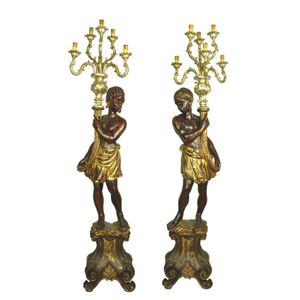Regency Revival Giltwood Wall-Lights with Eagle and Rocaille Mount
A pair of Regency revival giltwood two-light wall-lights, late 19th/early 20th century, each with eagle on rocaille mount issuing a pair of candle branches, the backboard formed as tied ribbon, height 67.5 cm (2). Provenance: Christie's London, The Collection of Professor Sir Albert Richardson, P.R.A.18 & 19 September 2013, lot 426
You must be a subscriber, and be logged in to view price and dealer details.
Subscribe Now to view actual auction price for this item
When you subscribe, you have the option of setting the currency in which to display prices to $Au, $US, $NZ or Stg.
This item has been sold, and the description, image and price are for reference purposes only.
- Giltwood - Giltwood is used to describe a gold finish on furniture and other decorative wooden items, whereby a thin sheet of gold metal, called gold leaf, is applied to the surface for decorative purposes.
Unlike gilding, where the gold leaf is applied over a coating of gesso, with giltwood the gold leaf is applied direct to the surface, or over a coat of linseed oil gold leaf adhesive.
Most gold-finished mirrors will be gilded, whereas furniture with gold highlights will have the gold applied through the giltwood method. - Regency Period - The Regency period in English furniture design refers to the period when King George III, was declared unfit to rule in 1811, and his son ruled as proxy as Prince Regent, until 1820, and then, after the death of his father as George IV until his death in 1830. The Regency period was preceded by the Georgian period (George I, George II, and George III: 1714 - 1811), and was followed by the William IV period, which only lasted until 1837 when William IV died as was succeeded by Queen Victoria.
This item has been included into following indexes:
Visually similar items

A sterling silver and rose gold shield pendant engraved Buttle's dancing Competitions 1929 Xmas
Sold by
in
for
You can display prices in $Au, $US, $NZ or Stg.

A pair of gilt and silvered blackamoor figures wired for electricity 170 cm high
Sold by
in
for
You can display prices in $Au, $US, $NZ or Stg.

Girandole mirror. Round convex mirror in gilt frame, with four branch candle sconces, (some loss)
Sold by
in
for
You can display prices in $Au, $US, $NZ or Stg.

Tibetan bronze Buddha on a lotus form pedestal with applied stone jewellery. Height 33.5 cm
Sold by
in
for
You can display prices in $Au, $US, $NZ or Stg.
